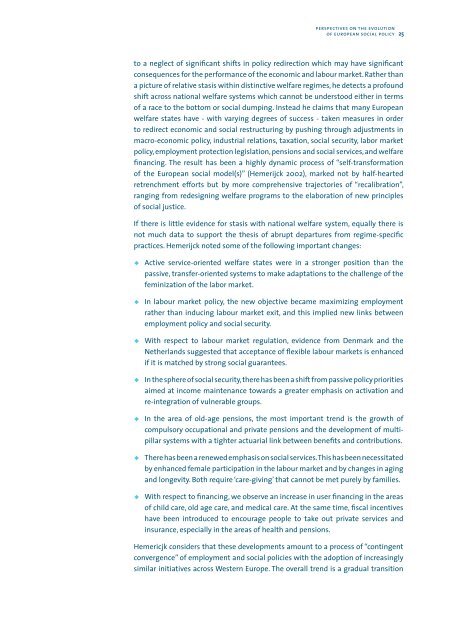4. Perspectives on the Evolution of European Social Policy
4. Perspectives on the Evolution of European Social Policy
4. Perspectives on the Evolution of European Social Policy
- No tags were found...
You also want an ePaper? Increase the reach of your titles
YUMPU automatically turns print PDFs into web optimized ePapers that Google loves.
perspectives <strong>on</strong> <strong>the</strong> evoluti<strong>on</strong><strong>of</strong> european social policy 25to a neglect <strong>of</strong> significant shifts in policy redirecti<strong>on</strong> which may have significantc<strong>on</strong>sequences for <strong>the</strong> performance <strong>of</strong> <strong>the</strong> ec<strong>on</strong>omic and labour market. Ra<strong>the</strong>r thana picture <strong>of</strong> relative stasis within distinctive welfare regimes, he detects a pr<strong>of</strong>oundshift across nati<strong>on</strong>al welfare systems which cannot be understood ei<strong>the</strong>r in terms<strong>of</strong> a race to <strong>the</strong> bottom or social dumping. Instead he claims that many <strong>European</strong>welfare states have - with varying degrees <strong>of</strong> success - taken measures in orderto redirect ec<strong>on</strong>omic and social restructuring by pushing through adjustments inmacro-ec<strong>on</strong>omic policy, industrial relati<strong>on</strong>s, taxati<strong>on</strong>, social security, labor marketpolicy, employment protecti<strong>on</strong> legislati<strong>on</strong>, pensi<strong>on</strong>s and social services, and welfarefinancing. The result has been a highly dynamic process <strong>of</strong> “self-transformati<strong>on</strong><strong>of</strong> <strong>the</strong> <strong>European</strong> social model(s)” (Hemerijck 2002), marked not by half-heartedretrenchment efforts but by more comprehensive trajectories <strong>of</strong> “recalibrati<strong>on</strong>”,ranging from redesigning welfare programs to <strong>the</strong> elaborati<strong>on</strong> <strong>of</strong> new principles<strong>of</strong> social justice.If <strong>the</strong>re is little evidence for stasis with nati<strong>on</strong>al welfare system, equally <strong>the</strong>re isnot much data to support <strong>the</strong> <strong>the</strong>sis <strong>of</strong> abrupt departures from regime-specificpractices. Hemerijck noted some <strong>of</strong> <strong>the</strong> following important changes:s Active service-oriented welfare states were in a str<strong>on</strong>ger positi<strong>on</strong> than <strong>the</strong>passive, transfer-oriented systems to make adaptati<strong>on</strong>s to <strong>the</strong> challenge <strong>of</strong> <strong>the</strong>feminizati<strong>on</strong> <strong>of</strong> <strong>the</strong> labor market.s In labour market policy, <strong>the</strong> new objective became maximizing employmentra<strong>the</strong>r than inducing labour market exit, and this implied new links betweenemployment policy and social security.s With respect to labour market regulati<strong>on</strong>, evidence from Denmark and <strong>the</strong>Ne<strong>the</strong>rlands suggested that acceptance <strong>of</strong> flexible labour markets is enhancedif it is matched by str<strong>on</strong>g social guarantees.s In <strong>the</strong> sphere <strong>of</strong> social security, <strong>the</strong>re has been a shift from passive policy prioritiesaimed at income maintenance towards a greater emphasis <strong>on</strong> activati<strong>on</strong> andre-integrati<strong>on</strong> <strong>of</strong> vulnerable groups.s In <strong>the</strong> area <strong>of</strong> old-age pensi<strong>on</strong>s, <strong>the</strong> most important trend is <strong>the</strong> growth <strong>of</strong>compulsory occupati<strong>on</strong>al and private pensi<strong>on</strong>s and <strong>the</strong> development <strong>of</strong> multipillarsystems with a tighter actuarial link between benefits and c<strong>on</strong>tributi<strong>on</strong>s.s There has been a renewed emphasis <strong>on</strong> social services. This has been necessitatedby enhanced female participati<strong>on</strong> in <strong>the</strong> labour market and by changes in agingand l<strong>on</strong>gevity. Both require ‘care-giving’ that cannot be met purely by families.s With respect to financing, we observe an increase in user financing in <strong>the</strong> areas<strong>of</strong> child care, old age care, and medical care. At <strong>the</strong> same time, fiscal incentiveshave been introduced to encourage people to take out private services andinsurance, especially in <strong>the</strong> areas <strong>of</strong> health and pensi<strong>on</strong>s.Hemericjk c<strong>on</strong>siders that <strong>the</strong>se developments amount to a process <strong>of</strong> “c<strong>on</strong>tingentc<strong>on</strong>vergence” <strong>of</strong> employment and social policies with <strong>the</strong> adopti<strong>on</strong> <strong>of</strong> increasinglysimilar initiatives across Western Europe. The overall trend is a gradual transiti<strong>on</strong>
















